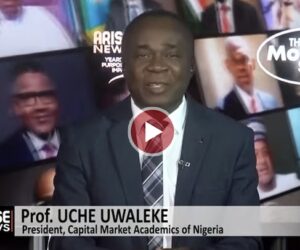These investors’ portfolios span an array of industries—from fintech, climate tech, gender-led, clean energy, food systems, cities, and creative Economy, BPO & logistics to health tech.
If you are familiar with African fundraising news, you can tell there has been a rebound this year after a weak 2024: startups raised 78% more funding in the first half of the year than they did in H1 2024. This week, Cameroon’s REasy raised $1.8 million in pre-seed funding, and four weeks earlier, Kredete, a Nigerian fintech, secured $22m in its series A funding. Every now and then, a successful fundraising campaign is in the news.
How do these startups do it?
Usually, it begins with a pitch deck. For founders, the pitch deck is a brief tool that articulates a product or service and its viability. For investors, a company’s pitch deck speaks volumes about whether to commit capital or not.
TechCabal spoke with six investors to learn what compelling pitch decks look like and what every founder and builder in tech should know when seeking investments.
Responses were edited for length and clarity.
1. The Big Why
For every problem you are building to solve, the purpose matters even more. The ‘why’ is your driver and gives foundational insight to many other layers.
Amara Uyanna, Global Strategy Manager at Schneider Electric, whose investment portfolio spans fintech, the energy sector, and e-commerce:
“Why does this company exist? What problem are they trying to solve? [If] I understand the problem they’re trying to solve, is there a market for it, will people pay? Is the market big enough? So what is the potential for growth?”
Favour Ubaka, Portfolio Manager, Catalytic Africa, with a portfolio in fintech, health tech, and climate-focused solutions:
“A strong pitch deck is clear, concise, and compelling. It explains the “why” of the business in simple terms, shows the size of the opportunity, and convinces me that the team is the right one to win.”
Call to action: Present the problem you are solving for, and differentiate what Unique Value Position (UVP) your product holds. Be clear and realistic about your competitive advantage for investors to recognise the opportunity you are setting the stage for.
2. Traction
Investors want evidence that the market wants your product or service, that it is not just an idea.
Muhammad Abubakar Usman, Venture Capital, Investment Analyst with Consonance:
“For us, evidence of traction is key—whether through revenue growth, customer adoption, or market expansion. We want to see signs that the solution resonates with the market and has the potential to scale.
Since we invest in high-growth, impact-driven companies in Africa—particularly in sectors like tech-enabled services, healthcare, education, agriculture, and financial inclusion—a strong deck highlights how the business model is solving large, urgent challenges. We want to see proof of market adoption, sustainable unit economics, and how technology or innovation creates a competitive moat.”
Ubaka drills on the necessity of traction for companies in specific industries:
“I want proof that the market wants what you are building; that could be user growth, revenue, partnerships, or pilots with credible institutions. A good idea is valuable, but demonstrated demand gives confidence that the business can scale.
For fintech, I want to see how you will build trust and scale in tough regulatory environments. For healthtech, I look for evidence of partnerships with hospitals, pharmacies, or insurers because going solo is difficult in that space. For climate solutions, I want to see how your model balances impact and profitability since many climate businesses lean too heavily on one side. In all three industries, traction or early validation is key.”
Call to action: Investors anticipate that your solution has customers willing to pay for it, and one way to present this is to show how many users you have acquired so far.
To also show market resonance, Jeffery Akemu, a Portfolio Associate with Launch Africa Ventures, a Pan-African fund, advises founders and builders to include customer feedback in their decks.
“It’d be quite nice to see that.” He goes on to explain, “For example, if you’re building a B2B product, and you can get feedback from two or three of your customers to include as part of your deck, I think that’s good. As a venture capital firm, we include it in our own deck. We have feedback from our LPs [Limited Partners], and we have feedback from our founders. So you want to get feedback from your existing investors. It is a validation mechanism for the person looking at the deck. Who are the people who also believe in this product? What people also believe in this idea right then, what people are currently paying for these products?”
3. Clear understanding of the market
Understanding the market for your product is one way to achieve a strong Product Market Fit (PMF), and investors want to know that you understand the market you are building for.
With experience across African regions, Akemu explains, “For example, if an investor is investing in Nigeria and wants to invest in a mortgage startup, historically, that has been a tough sector to hack in Nigeria. But it’s not as tough in North Africa or in South Africa, because mortgages are already an existing product there, and people constantly use them. Remittances also work well in Nigeria. But remittances are a bit difficult in countries like Algeria.
Because of the capital restrictions, it’s also difficult in a country like Ethiopia. And so the nuances of the countries also affect what type of investments we make. Each region has peculiarities, and when we want to invest, we have to take into account the cultural nuances of the region.”
Akemu adds, “If you don’t understand the market well enough, then there’s a challenge there. Understanding of the market is quite key.”
Call to action: Akemu advises founders and builders that one way to understand the market is to run an early adopters test and speak to users to understand their pain points and what they need.
4. Clear use of funds
With projections and budgeting of funds, investors expect a presentation of how those funds will be used.
Samuel Frank, Investment associate, Sahara Impact Ventures:
“Where is the money going to? Where does that money lead you? If I give you $1 million, will that move you from $100,000 in annual revenue to $3 billion? Where would that money take you? I think that’s something that I find missing in the decks I’m always wanting to see.”
Call to action: Be plain with the funding you expect, financial projections, and how they will be used.
5. An aligned team
When building, it matters to investors that your team represents your vision and values. Investors want evidence that your team has the capacity to execute on the problems you want to solve.
Aishat Hassan, Portfolio manager at BRB Capital, with speciality in early-stage investments in startups focused on clean energy, healthcare, and financial technology:
“I’m particular about the team, what they are trying to build, the people behind this team, and their experience in the industry. I need the proof that the team can build what people actually want to use and what is scalable in the market.”
Uyanna, also emphasises the team; “The North Star [of success], for me, is the team. Great pitches and great business ideas; anybody could have those. But the magic sauce is in the execution, which, at the end of the day, comes down to the people in their willingness to show up, in their willingness to be innovative, in their willingness to not cut corners, in their willingness to have integrity as they deliver while prioritising returns and impact as much as possible.”
Frank, who invests in companies with an impact on gender, shares the importance of the team that does not reflect gender disparity: “I’m looking for a pitch deck that aligns with the thesis for which I invest. So first, [if it’s a male founder] does he have a female co-founder, or is a significant percentage of the workforce or the management team women? I’m trying to spot this out by the time I look at the deck.”
Call to action: Before the deck is pooled together, the team you are building matters. Assemble a team that reflects what you are building for.
6. A clear progressive story
Clarity affords focus. Investors want to get through your deck seamlessly, without the important elements getting mixed up. It is crucial that the messaging in your deck is simple yet compelling.
Akemu notes, “I like decks that take you on a journey, because at the core of it, the pitch deck is how you first hear a company’s story, before the founder. You can see the thinking. That it flows sequentially and explains how the business has evolved as it goes along.”
“Storytelling matters.” Ubaka shares, “If I can understand the problem, solution, team composition, and business model quickly without fluff, then it works for me.”
Call to action: Document your startup’s journey in a clear and easy-to-understand way. Make sure your story is compelling enough to make you stand out in the crowd.
Hint: See Femi Aluko (Chowdeck’s CEO), now legendary Medium article details how and why he started Chowdeck.
Red flags: What should not be in your pitch deck?
In a pitch deck are indicators of success, but also indicators for concern. If these are in your pitch deck, you might need to modify them before sending out your deck.
Little market insight
Sam Frank:
“I see pitch decks where the founders have not clearly articulated why they have such a market size and what will drive that market growth. When you do a market sizing and put all of those wonderful things, you have to add the source. If you copied it from the internet, provide a source so that I can click on it and find that data. But a lot of the time, it’s not there. There needs to be background data for how many people you plan to serve, and that number of people was also backed by research. There must be some form of insight back in it.”
Jeffrey Akemu:
“Information you leverage from the internet and include in your deck, without it being well researched, I think people find themselves making that error. I don’t typically like a deck that will say the opportunity is [$]1 trillion without any backing to see how they came about that number. In a lot of decks, you find that the market opportunity or the market size and slides are not done properly. It’s copy and paste. Data is not researched. So that gives me the position of, ‘Does this founder really understand the market? Does he truly understand the market opportunity?’ ”
Inflated numbers
Amara Uyanna:
“I’ve seen a lot of pictures or statistics that have the sole purpose of eliciting, eliciting emotion, rather than concrete logic. There is a place for emotion, but that should be secondary. The why, the logic, and the essence should be solid first. If your numbers are so inflated, that’s also a red flag.”
Favour Ubaka:
“Overinflated market sizes without context. Unrealistic financial projections that look more like guesses than strategy are also a red flag.”
Misalignment with investors’ theses
Frank:
“When a deck is sent to me, and I see it doesn’t fit my thesis, I move on.” Frank says, “I think that can be an error from founders who don’t research investors and just think every investor is an investor for them.”
Unclear business model
Ubaka:
“Vague business models that look like ‘we will figure it out later’,” then goes on to add, “Ignoring competition. If a founder says they have no competitors, it shows they have not done their homework.”
Confusing language
Muhammad Abubakar:
“Buzzwords without substance. Example, saying “AI-powered” without a clear explanation.”
Ubaka says, “[When there is] too much technical language that makes the story confusing.”
Inconsistencies
Uyanna:
“If I see a lot of typos in pitch decks, or there are inconsistencies, from font size to the flow of the solution, that’s also a red flag. Because it becomes a question of, ‘did you not know, or are you intentionally trying to be dubious?’”
Investment advice
Flexibility with investment instruments
Sam Frank:
“Founders who are going around and they’re like, ‘if it is not so, so and so instrument. I won’t accept it.’ But if you notice, debt funding has been rising significantly. And one thing that debt funding is unlocking is unlocking more equity. With more debt funding coming into businesses, it allows these startups to prove that their business model is sustainable, and they can repay the debt. So that when people bring money to own a piece of your business, they are sure they will eventually exit. So founders should be a lot more open to different instruments, because VCs are trying to figure out what form of capital structure allows them to return money to my LPs [Limited Partners].”
Female founders
Sam Frank:
“Female founders should be more resilient when it comes to fundraising. I think that we don’t have a lot of them, and it’s a concern.”
Your pitch deck will speak before you do
Amara Uyanna:
“Your pitch deck will enter rooms that you are not in. A lot of times, founders prepare pitch decks for when they present the deck. While that might be, a lot of times, your decks will enter rooms before you do. So you need to make your decks comprehensive, simplified, but also as detailed as possible. Such that when I see that deck without you, I don’t need you to explain things to me. I follow up with questions, but not because the deck by itself does not tell a complete story.”








